Modern Wargaming With “Force-on-Force” Part Two – Morale & Irregular Troops
February 15, 2016 by crew
Good afternoon, Beasts of War. Once again it’s time to saddle up, lock n’ load, and continue our exploration of Force-on-Force – the modern warfare gaming system by Ambush Alley Games and Osprey Publishing. For those “just in from the world,” you can catch up on what we’ve discussed so far in Part One.
But for now, the chopper’s waiting. Mount up and keep your eyes open, troop.
Morale - Friend Or Foe?
No matter how tough or well-trained a unit might be, everyone has a point at which they “lose it.” A better trained or experienced force should be more ready, or even used to, being fired at. However, any force losing a fight, under certain conditions, will be forced to withdraw or even run for the hills.
In Force-on-Force, troops take morale checks under different circumstances. These are known as morale checkpoints. These can come when the unit takes casualties, are fired upon by very large weapons, are nearby when an IED (improvised explosive device) goes off, or is subjected to air strike or artillery barrages.
Force-on-Force also has three “Confidence Levels” for troops. These are High-Confidence, Confident, and Low-Confidence. All soldiers have to make morale checks in the above conditions, but Confident and Low-Confidence troops have to check under additional conditions that do not bother troops of higher confidence.
Interestingly, morale checks are also required when the unit kills or injures a non-combatant. This CAN happen unintentionally in the game, and few things will bring trained soldiers to a breaking point faster than finding out they’ve cut down a civilian or a friendly.
To make a confidence check, each figure in the unit has to roll a TQ (troop quality) dice. As usual, 4+ is a success. Generally speaking, if more figures in the unit succeed in the check rather than fail, the unit stands. Otherwise, the unit is pinned. Multiple pins can cause a unit to fall back to a covered position away from the enemy.
Note that multiple morale checkpoints of different types compel a unit to make multiple morale checks (multiple checkpoints of the same type only count once). This is particularly true of the lower Confidence levels, since they have more checkpoint conditions that compel checks in the first place.
Also, since troops of different levels roll different sizes of TQ dice (militia roll d6 while elite SAS or Navy SEALs would roll a d12, making that 4+ is much easier for higher quality troops. However, everyone has a breaking point. Even elite Delta Force operators can come apart under the right … or the wrong … circumstances.
Units that fail morale checks are pinned. They stop moving toward the enemy, seek available cover, and suffer penalties to their attack and defence. Units that are pinned twice in the same turn must “Pull Back,” actually retreating away from the enemy to any available cover. They must then “Regroup” on their next turn.
This is the point that training, discipline, and experience play a crucial part in Force-on-Force. The “penalties to attack and defence” mentioned above is what is called a “die shift” (e.g., d8 troops become d6 troops). Note that if d6 troops shift to below d6, they can’t do anything besides hold onto their helmets in a fetal position.
Assuming they were not reduced below d6 in Troop Quality, pinned units are just restricted in movement, penalized in firepower (especially during subsequent “Reactions” taken that turn), and made temporarily more vulnerable to enemy fire. Units that are pinned become unpinned at the end of their turn.
Units that were compelled to “Pull Back” must spend their next turn “Regrouping.” Regrouping units can shoot back during a “Round of Fire,” but may not initiate a Round of Fire on their own or go on Overwatch (cover other friendly units). Nor can they move until they have completed their Regroup.
Please note that all these morale rules apply to actual soldiers, troops that have been trained in some way. “Irregular” militants, such as rebels, terrorists, insurgents, or other untrained combatants have a different set of checkpoints and potential morale results. There are even rules for insurgents who use drugs before a battle.
These morale rules really are straightforward. Once you’ve run through it a couple times it becomes second nature, and you can focus on the action rather than the rules of the game.
Insurgents & Irregulars
Many modern wargames seem to focus on regular forces against the classic “insurgent” militia, insurrections, or rebellions. This is called ASYMMETRIC WARFARE, which characterizes the way most conflicts are being fought in the world today. Therefore, Force-on-Force pays special attention to the particulars of asymmetric warfare.
In asymmetric warfare, one side is made up of trained soldiers, usually well-equipped and backed up by powerful support assets. These are pitted against a force of untrained (but highly motivated and sometimes frighteningly well equipped) irregulars.
What makes this kind of warfare “asymmetric” isn’t just the numbers. Indeed, many times the “government troops” heavily outnumber the irregulars. The differences are in the tactics available to both sides, and what both sides are willing to accept as “victory.” This translates to special rules and victory conditions in a Force-on-Force game.
Admittedly, untrained irregulars have many weaknesses when compared to a formal, trained, official army. However, they also have colourful characteristics that are reflected in the slightly different mechanics used to play them.
At this point, don’t make the mistake in thinking that playing against insurgents is a push-over. Insurgencies have beaten many of the most powerful nations in the world, the list is too long to go into here. Irregular units tend to be highly motivated and you’re always fighting on THEIR home ground.
Additionally, insurgent forces tend to be very numerous. Well-trained troops might not be concerned about insurgents’ ability to shoot straight, but when there is a lot of them firing at you? Also, they’ll almost always hit first, run away when they choose, be ready to take hideous losses, and have easy victory conditions.
Irregular units do have serious drawbacks, however. For one, they don’t have a flexible command structure. Because they have no formal training or knowledge of battlefield techniques, they require direct command when fighting, leaders that they trust (usually on a personal level).
This leader must be attached to the unit or be within range to issue instructions. With no one shouting commands at them, an irregular unit may only be activated if they can pass a troop quality check (which is usually made on a terrible d6, remember).
Irregular units that are have an attached leader or a leader in range, may be activated just like any other type of unit. However, a “leaderless” irregular has to make the aforementioned TQ check. If they fail they must remain where they are. They can shoot at anyone who shoots at them (who wouldn’t?), but that’s about it.
At any point during a game, should the entire irregular command be removed, the irregular side’s morale suffers a -1 die shift. If this takes their die below a d6, then the unit becomes combat ineffective and is removed from play. With nobody left to shout at or threaten them, disheartened soldiers drop their weapons and vanish as quickly as they appeared.
We hope this second article only heightens your interest in Force-on-Force, or modern wargaming in general. Please feel free to post questions, comments, or feedback below, and tune in next week when we continue our explorations of this great game system.
If you would like to write an article for Beasts of War please contact us at [email protected] to find out more!
"...however, everyone has a breaking point. Even elite Delta Force operators can come apart under the right (or the wrong) circumstances"
Supported by (Turn Off)
Supported by (Turn Off)
"Many modern wargames seem to focus on regular forces against the classic “insurgent” militia, insurrections, or rebellions. This is called ASYMMETRIC WARFARE..."
Supported by (Turn Off)









































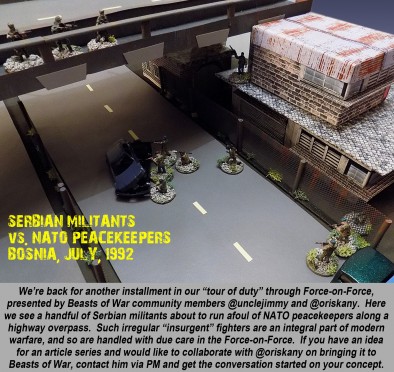
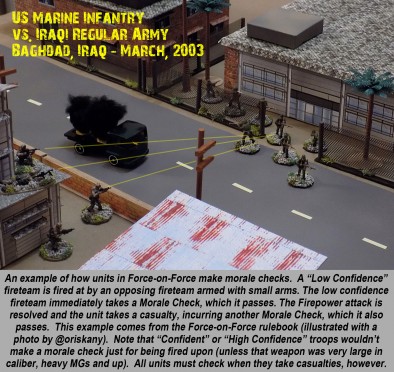
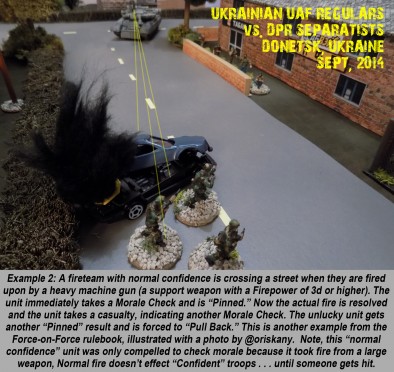
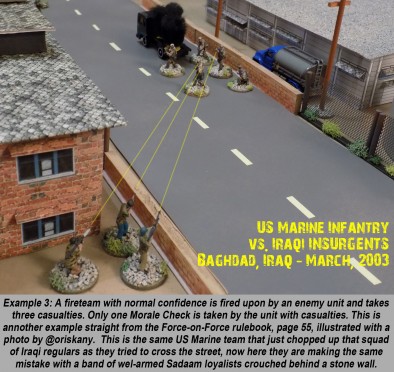


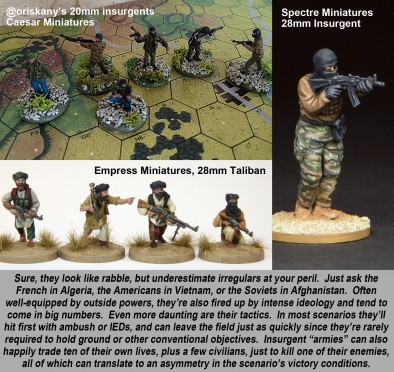
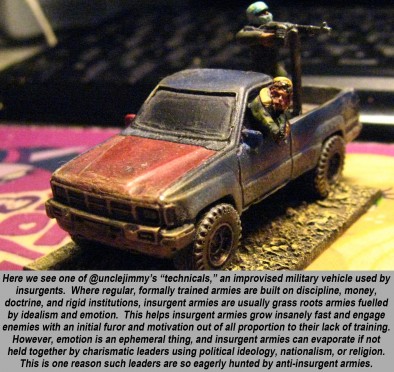


































Loving the article, chaps. Would this work for the Falklands War? Or is that a little large for the ruleset? Also…anyone know a place to even GET Falklands era minis? 😛
Thanks, @crazyredcoat . 😀 I certainly think that certain engagements of the 1982 Falklands War could be easily recreated to great effect with Force-on-Force. As with any conflict, Force-on-Force works so long as you take a small enough piece of it to your table top. After all, some people use Force-on-Force for World War 2, there a “Covert Ops” sourcebook that handles (among other things) WW2 commando missions. So if there was any war that was “too big . . .” I found these Falklands-era British infantry on CP Models. On the menu to the left just across down to… Read more »
We put a Falklands scenario in one of the Force on Force books.
It was designed to be a symmetrical warfare set following the original Ambush Alley that was purely designed for asymmetrical warfare.
I suspected as much, @piers – I don’t have all the sourcebooks . . . but saw Falklands UK troops pictured in the main rule book. The full range (that I know of) FoF support supplements are covered in Part 04 of our series. 😀 Also, the main book has at least one scenario (this might be the one to which you’re referring), partially outlined below: SCENARIO 1: TOP MALO The Falklands, May 31, 1982 A small element of Argentine Army Special Force from Commando 602, under the leadership of Captain Verseci, were forced to retreat from their observation post… Read more »
…he did!
Hey, look who’s back! It’s @unclejimmy !
Great article! @oriskany what did you use as bases for your 20mm irregulars?
Thanks, @lblunchboxlb . Sadly, these insurgents are graduates of the “Oriskany On the Cheap” school miniatures. 😀 Small wooden disks, as linked below . . .
https://woodcrafter.com/m01382-circle-woodsies-pkg-of-130/
. . . spray-painted a muted green, then coated in Elmer’s wood glue and dunked in slightly-mashed up (wait for it) . . . cat litter of all things. That’s the gravelly texture. Finally, a few bits of typical hobby moss to cover up wherever the cat litter didn’t hold or was knocked off while painting the rest of the miniature.
@oriskany that’s an amazing idea for the cat litter! I buy 3lb bags of it from the $0.99 store to protect my garage floor from spills. Now I have another use for it!
Totally @unclejimmy‘s idea. I learned at the knee of the master. You probably already know this, but I always buy the unscented kind. Then I take a handful and tap it a little on some concrete with a small hammer, just to break it up a little. I know some people who mix it with big-grain sand as well, to provide a little more variety in the texture. It’s a little messy, and little bits will fall off at first. But that’s what the moss covers, and why the base is painted a grassy brownish-green underneath. That way, even if… Read more »
@oriskany i find a 2 stage gluing technique pays dividends with chunkier basing materials, paint on your pva/elmers undiluted, and dunk base in material you are using. Once dry dilute some pva/elmers 3parts water to 1 part glue, so its like milk, then paint that on the base, really slop it on you want it to get into all the cracks, it really helps get it stuck down good, then you can dry brush and will have a lot less material come off, also makes them a lot more resilient to dings so your bases will look great for years… Read more »
Awesome, @nakchak ! So the rocks / pebbles / sand gets “sandwiched” between the base glue and the diluted glue on the top . . . I’ll give that a try with my next batch (hopefully a long time, I’ve really had my fill painting infantry lately 🙂 ).
@oriskany Exactly that, it becomes the difference between stuck down and stuck fast, you can also paint the diluted mix on top of finished and painted bases as the glue dries clear and its dilute enough to not be that glossy either, but will allow you to get a lot more use out of the bases before they look like they are balding. Only down side i have found with kitty litter is when a large chunk falls off it can be quite noticeable, but doing this minimizes that happening.
Thanks, @nakchak – “Only down side i have found with kitty litter is when a large chunk falls off it can be quite noticeable . . . ”
Indeed. That’s what the moss has been covering. 😀 The bases look better with a little random bit of undergrowth here and there, the “bald spots” of litter are just informing me where the “random” undergrowth will go. 😀
You can also use really fine sand and add it after painting – then you don’t need to paint the ‘ground’ as it is already the right colour!
Enjoyable read guys, many thanks for taking the time to write this up for us.
Thanks very much, @brucelea ! 😀 Thanks for taking the time to read and post.
Quality stuff guys, you keep it up and i will cave in and give modern a go, as much as i love my sci fi i think this is the breath of fresh air i need in my gaming life at the mo…
Thanks, @nakchak . Sci-fi and Moderns really start to blur into each other, depending on how far forward you push the modern concept and how “science fact-ion” you like your sci-fi.
Like Fantasy vs. Medieval / Ancients, the two genres can share a lot of common ground.
@oriskany I love my hard-fi when it comes to fiction, but when it comes to gaming i find the plausibility less important, that said the near future would be an interesting place to game, especially if in that universe DARPA has (an even more ;)) unlimited and unaccounted for budget, wonder how long until we have a cyber warfare game, could be a lot of fun having a game like risk where you attack each others infrastructure, in fact i may have to pic your brains on creating a hex based game along that premise… Never mind sinking battleships, you… Read more »
Some games I’ve read about that are trying to be semi-based on some kind of cyberwar concept use almost a “Ticket to Ride” route-based system, where you try to build up some kind of transit network in competition with other players (carrying data instead of passengers / freight) – with an added mechanic for actively attacking enemy infrastructure through hacks, espionage, etc. (espionage as in . . . why go through the trouble of hacking the enemy’s source code when you can toss some money and a high-end call girl at one of the enemy’s system administrators?) I also have… Read more »
Depending on how much of the stuxnet analysis you believe does seem that the engineer that inadvertently brought the compromised pen drive into the facility was actively targeted by mossad/cia, the fact it got out into the wild was a massive balls up by them seems the pen drive was passed onto another engineer who went on to other facilities and infected them, for once a cybersec story does live up the hollywood hype, just without the unusable 3d desktop the SFX team always seems to use to show “H4x0r1n9”, rather than the real life tedium that is a SSH… Read more »
From what I’ve read (and I am no by NO MEANS an expert on this stuff), a great deal of a hacker’s capability has to do with the tools at his disposal, and I don’t just mean his computer or his/her/their network. The “dangerous ones” are armed with drives or air-gap laptops loaded with pre-written hacking software, much of it “perverted” or “subverted” versions of actual security software. Almost like, if a house has a lock on it, and you have a COPY of that lock, you can use it to make a key that will open the target lock.… Read more »
@oriskany thats very true, although subversion of security tools is actually just a contextual thing, a “security tool” and a “hacking tool” are the same thing, they tend to be unmodified its what you do with it, in the same way that its not subverted weapons on the other side uses in a war, just a difference in target selection and attitude to their use. There is a reason crypto is classified as munitions and has (impossible to enforce, due to ubiquity) sale restrictions placed on it. When talking about proper hackers (or security researchers as we tend to call… Read more »
@nakchak – This is starting to sound too much like work. Not work to create the game, but work at the office! 😀 I still like the idea of a squad of elite call-girls at a tech convention. 🙂 All these developers, execs, engineers away from home in a big city somewhere, approached by ladies who happen to boost a laptop, phone, or pad after their mark has crashed for the night. Just a few licenses, user accounts, etc. Eh . . . maybe not. It’s not like the poor guy wouldn’t know his device wasn’t taken. And I doubt… Read more »
@oriskany there are tales aplenty like that from defcon and blackhat in vegas, one day shall blag the budget to attend 😉
@nakchak – the closest I’ve ever come to an event like that was in my old role I was asked to design some graphics and displays for the booth / table stations, and some distribution literature. They started hinted that part of my “reward” would be attendance at some of the more local events (Orlando, Tampa), at which time I assured the team that was NOT necessary. 😀
You don’t have to abandon sci-fi at all. We got a copy to Tomorrow’s War and you can make your ‘Tommorowverse’ anything you like. Then add some very interesting aspects to FoF – like the GRID.
I think I will have to write an article on it next.
I’ll send a template on the article format that gets submitted to BoW. 😀
I’m really tempted to give this a go when the new warlord plastics come out
Make you a deal, sir. I’ll teach you FoF, you team me Saga. 😀
“Oh Lagertha! How many men must I slay for you? Seriously, girl. Just gimme a number.” 🙂
http://images6.fanpop.com/image/photos/37800000/shieldmaid-lagertha-lagertha-lothbrok-37873593-2655-3543.jpg
BoW should do a bootcamp!
…no – just go 20mm.
Hardly costs anything and you can make great buildings from foamboard. If you want to see some of mine i’ll post them on our weekend thing that @chrisg is running.
Do it – you know you want to!
damn it.
Stop making me want to buy these books.
Looking forward to the next entry in the series. 🙂
Are there any reasons why this system doesn’t support conflicts prior to 1940 ?
There have got to be a few small scale engagements during WW 1 that could be done using the system.
I’m thinking of the bridge defense as shown in the ‘first day’ episode of ‘our world war’.
http://www.bbc.co.uk/programmes/p022wq5k
I can’t really think of one, @limburger . The basic system should still be sound. If I can take a moment to really generalize here (hopefully @piers approves 🙂 ) . . . It seems to me that Force-on-Force was built on the basic premise that most soldiers are armed with similar weapons. So instead of counting millimeters or rounds-per-minute or grain-weights of each bullet, it puts the emphasis on the quality, training, and confidence of the soldier behind the weapon. So if whether you’re a soldier in Fallujah or Flanders, if you come around a corner and find yourself… Read more »
I can see it working for the Spanish Civil War and Irish War for Independence as it is all about troop qualities and properly assigning training and morale.
Vehicles in these older conflicts would also certainly be interesting. Sure, there are no RPGs or LAWs, but there are certainly Molotov cocktails . . . and of course these “armored” vehicles are hardly rockin’ the Chobham armor and ERA panels . . . 😀
http://forum.irishmilitaryonline.com/attachment.php?attachmentid=5744&d=1304509354
So use the Improvised Device rule or “Stickey” with Molotov for the close proximity needed. Honestly, those “arrmored” vehicles are nothing more than soft skin. Hit that with a Boyes, and you have shrapnel bouncing around inside the darn thing.
We couldn’t think of anything that these rules couldn’t be used for. They have been used to stage bank robberies (a modern version of Kelly’s Heroes) and even ‘paintball’ training matches between spec4 units! Simple…
Kelly’s Heroes ?
lol … I wonder how you’d do that tank with the really big gun that goes faster in reverse 😉
I was thinking ‘Three Kings’ given the modern setting ( http://www.imdb.com/title/tt0120188/ ) , but yeah …
Or even A-team (with a proper body count ;))
“Crazy, man. Like . . . so many positive waves, maybe we can’t lose. You’re on!”
During playtesting we used FonF for an Irish Civil War campaign.
See, it’s been done by the master!
I love all the details! It’s like I’m playing the game without having to buy anything! It’s also refreshing reading about something different…not sci fi…not zombie…not WWII…not goth/punk
Infantry looks great, but that technical almost takes the cake 🙂 Who needs a tank when you can have a rusted out toyota with with a 50?
Thanks, @gladesrunner . I’ve actually read somewhere that Toyota is actually starting to perceive something of an image problem . . . ever since the 1980s when the CIA was selling TOW missiles to rebels in Chad to mount on Toyota trucks to hunt Libyan tanks . . . Toyota has been the truck of choice for rebels, insurgents, and terrorists. Seriously. I guess it’s the low cost? Reliability? Ease of availability (and thus, spare parts)? But seriously, Toyota’s starting to become known as the “ISIS Mark 01” and the guys in marketing are starting to worry. These are customers… Read more »
Not as bad as the Ford truck sold to ISIS!
http://www.cnn.com/2015/12/14/us/terror-truck-lawsuit/
Poor guys was receiving hate calls.
That’s crazy. Note to small businesses . . . when you trade in your old commercial vehicles, be sure to remove your branding and phone numbers before you trade in your trucks, or they might wind up “advertising” your company in the worst of places! 🙁
That and as top gear proved the hi lux is indestructable, http://www.youtube.com/watch?v=0r9AG4qD-xs
i mean it started after sitting on top of a building being demolished, set on fire, sunk, and smashed with a wrecking ball! 😉
not sure why top half of comment was cut off…
I was saying top gear proved the hi lux is indestructible, after doing various things to it
https://www.youtube.com/watch?v=0r9AG4qD-xs
I wouldn’t consider the publicity completely bad. If you’ve built a civilian vehicle rugged and reliable enough to survive in some of the harshest environments on earth (an active war zone in the middle of the desert counts, right? 😛 ), then that’s a vehicle I’d be interested in buying!
car manufacturers are afraid of anything that might damage their image.
That’s why even (video)games rarely have realistic damage profiles.
They don’t equate “our brand is in the news” with ‘good for business’.
Then again … if you get people angry at a business simply because their used cars were used by bad guys it isn’t that hard to understand why they don’t like it.
Add to this the fact that trading with the ‘bad guys’ (as defined by whoever the USA dislikes) is against the law. So Toyota & co have additional reasons not to want their products in the news.
Oh, I agree @lblunchboxlb . These vehicles are in use for their good qualities. I guess it’s just one of those things were people would rather forget the less savory aspects. I wouldn’t expect to see an ISIS endorsement for Toyota or Ford at the next SuperBowl commercial. 😐
As far as “defined by who the USA dislikes?” . . . I think I’d best leave that alone. 🙂
I love the insurgent doing his ‘drive-by’! S&S miniatures for anyone who wants some. Pretty easy to take out with a squad, but if they can dish-out some damage if they get the chance.
I missed out heaps of other little details that make it even better – I couldn’t cover everything.
really good article series James and Darren well done
Thanks very much, @victoriag !! 😀
Thanks!
Great article. I’ve had the F/F book for a while now but never the opportunity to play with it. It’s a good excuse to get these great moderns from Spectre and Empress and the scenarios from Too Fat Lardies.
can someone possibly point me in the right direction for technicals/suvs and humvee in 28mm scale? proxy plastic kits, toy car ranges anything really that can be picked up cheap?
Thanks, @tomatovich and @toshkien . Honestly, I’ve had a helluva time finding HMMVWs in 20mm . I haven’t even considered making the jump to 28mm.
I did find this, though . . .
http://www.lead-adventure.de/index.php?topic=48210.0
Looks like someone found some HMMWV toys they were able to repaint.
20mm vehicles – http://www.sandsmodels.com/
This site has some of the very best 20mm stuff – ANYWHERE! If you want ‘odd’ things they might even make them for you. Check it out.
What about 1:48 model kits ?
http://www.tamiya.com/english/products/32567grenade_launcher/index.htm
It’s not cheap though :
http://www.amazon.com/Tamiya-Modern-Utility-Vehicle-Grenade/dp/B003198FG8
And it’s got way more detail and parts than wargaming models do :
http://www.armorama.com/modules.php?op=modload&name=SquawkBox&file=index&req=viewtopic&topic_id=182353
At officially, according to the site, Force on Force is mostly written for 15mm, 20mm, or 28mm (1:100, 1:72, 1:56). I don’t see why you couldn’t play at 1:48 (35mm?). That’s Dust scale, right? You’d have to just adjust some of the movement rates, etc, but I don’t think it would be too hard. Personally, I’ve found that 20mm 1:72 is the best for Modern games. I know I hit this in this series and also back in the Ukraine series, but once again, so many of today’s conflicts take place in heavily-built up areas. This presents the wargamer with… Read more »
Thanks for the info.
I didn’t know the correct scale for 20mm.
I remember seeing lots of 1:72 scale soldier models when I was into plastic model kits (although I preferred 1:35).
Finding shops that still stock plastic model kits is tough these days. 🙁
There used to be a really good one near my home town.
I hope that the price on this kit is wrong. Over 400 Pounds ? *ouch* :
http://www.amazon.co.uk/Revell-03137-HMMWV-1-72/dp/B0002Q0WEG
http://www.armorama.com/modules.php?op=modload&name=Reviews&file=index&req=showcontent&id=1110
http://www.dragon-models.com/d-m-item.asp?pid=DRA7294
…it must be!
cheers guys im having the same problems really with sourcing stuff in 28mm, i guess thats why everyone at club went 15mm (not my fav scale really), will have to keep an eye out in the bargin pound shop for stuff like those marvel humvees.
if anyone is interested here is three part guide on building a FoF 15mm game setup, https://wargamesasp.wordpress.com/category/modern/ all credit goes to Gareth at Aide-de camp painting for the guides as its normally him running FoF at club aswell 🙂
@oriskany the 20mm option sounds more appealing to me than the 15mm stuff for sure.
Indeed, @toshkien – 15mm is a bit small for Force on Force. It works, but it’s not my first choice. The battles that FoF tries to recreate are relatively small (I play 20mm on a board 2 1/2′ by 3′ – @unclejimmy plays 28mm on board 40″ on a side), so it you try it on 15mm your board will possibly be VERY small . . . Or you will have a battle that is too large and cumbersome for a system as detailed as FoF. Again, this isn’t a system for Prokhorovka-sized armegeddons. 😀 Admittedly, some of the photos… Read more »
No, Unclejimmy plays 20mm! However, I do use a 40″x40″ board – that is all the space you really want. Your games should start as a contact.
Sorry, @unclejimmy . My bad. 🙂 But yeah, the boards are pretty small by many mini wargaming standards.
so how far back can this game go probably WWI onwards for sure @oriskany certainly a game worth considering.
@zorg – They’ve released books as far back as 1940, but some of the other guys on this thread have talked about WW1, and @piers has a forum thread going about a FoF playtesting game run in Irish Civil War 1922.
before WWI army’s were more Napoleonic it was the killing fields of the great war that changed military doctrine to more varied/modern thinking. @oriskany
The Great War was certainly a salient point in a rapid evolution of warfare, extending perhaps from 1850 to 1945? The overall arc of that change can probably be traced back to the ACW or even the Crimean War, when the Industrial Revolution first started to impact military factors like production, logistics, rail transport, and even the telegraph. Social changes like photographs from the battlefield also started to change people’s minds about war from a Napoleonic mindset to a new, post-industrial attitude. It’s interesting to see the American generals on both sides of the 1861-1865 Civil War start out with… Read more »
There was a colonial version under development years ago. I used it for Boxer Rebellion.
It’s quite easy to use for anything with breech loading rifles.
Was I completely off my rocker with the “guesses” regarding the +2 or +3 bonus for automatic weapons? As mentioned above . . . Make automatic support weapons like MGs a +2 or +3 instead of the usual +1 in FoF? This is because, in the usual FoF environment, basically everyone’s carrying an automatic or semi-automatic weapon (assault rifles and SMGs). While in 1914 (or even before), everyone’s carrying a five-round bolt action rifle of one variety or another. This makes automatic weapons of the day like Maxims and Vickers . . . (or even Gatling Guns) more fearsome by… Read more »
Sorry I have been ‘missing’ since this was posted.
I am enjoying the articles, guys. Good job! Can’t wait for you two to write the zombie supplement!
Braaaaaaaaains! 🙂
Ambush Z wad released sometime ago… remember testing that one Halloween!
I play it all the time – it is brilliant! I still nedd to buy a couple of those bags of Zombies that Elheim make. They are beautiful.
Maybe I will write one…(they’re coming to get you Barbara!)
p.s., thanks for all the feedback everyone. @oriskany will tell you I was shitting myself before it was posted by BoW.
It’s true, but I kept telling him he was in good hands. I’d “take good care” of the article, then Ben and Lance would take good care of the article, and finally the community would take good care of the article because overall this is a very positive and supportive group. 😀
Only just got round to reading the first two parts of this series, but finding them really interesting so far. I will definitely pick up a copy of FoF at some point. I’d heard bits of stuff about it before now, but not really got a feeling for how all the elements worked together. It sounds very interesting.
Thanks, @angelicdespot . In upcoming installments we’re talking about scenarii design, casualties, vehicles, and support supplements. So hopefully we’ll have presented a reasonable cross-section of what Force-on-Force has to offer. 🙂
Hey guys, I like the so-called post-modern stuff (abrams tusks, leos2, m-atvs, etc…) So before entering the wargaming world I read a bit and decided to go for FoF But mainly due price (thing get really expensive when you convert and pay taxes here in Brazil) I went for 6mm. I heard some people saying you might play FoF on 6mm. My experience is that it gets too hard to keep track of the units, specially the casualties, I wouldn’t recomend playing FoF on 6mm, but I don’t know if anyone with more experience has a different opinion, maybe a… Read more »